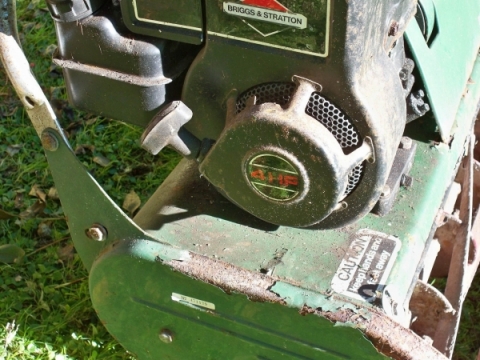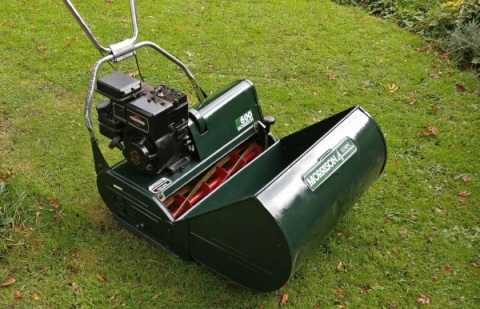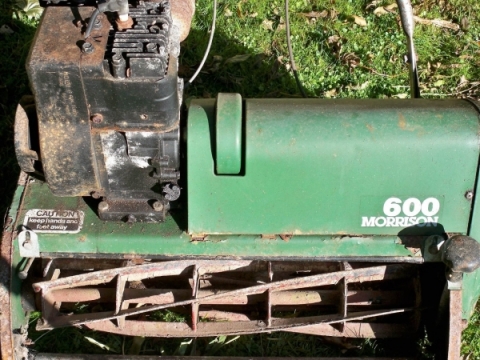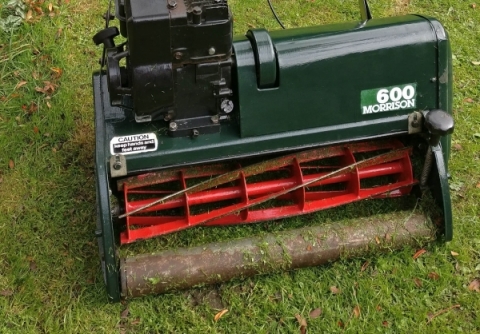B&S 4HP running very rich
This is the continuing story of my restoration of a Morrison Olympic 600 but as this problem concerns the engine and not the cylinder drive sprocket I thought I should start a new topic.
I have finally got to the point of reconnecting the engine - a 1988 4HP Briggs and Stratton Model 112232 Type 0839-01 - to the mower. I cleaned the petrol tank and carb, fitted a new diaphragm to the pump (it's a pulsajet type carb that lifts fuel from the tank up to an internal reservoir built into the top of the tank) and generally tried to blow out all the internal orifices with carb cleaner and air. I also fitted a new gasket between carb and fuel tank. The fuel tank cap is in good nick and of the plastic variety with internal metal lugs that hold it shut. Confess I don't know how this type of cap vents but it doesn't look faulty.
There is a decent spark and I have lapped and checked the valve clearances. The valves, cylinder and piston looked in good nick - top of piston still shiney and not much carbon build up. The adjustable jet is set 1-1/4 turns out from fully seated. The carb has one long plastic tube that reaches to the bottom of the fuel tank and one short cast aluminium tube on whose side is a fixed brass jet. There is a very good description and photos of this type of pulsajet carb on the Outdoor.com website.
However, to my disappointment, the engine is reluctant to start and having started is not particularly responsive and eventually peters out. I tried adjusting the idle jet screw on the side of the carb but it seemed to have little effect. I also found that when I took the air cleaner off it started immediately but nevertheless would not continue running for more than a minute or so. Checking the spark plug (a new one) its black and I can see the top of the piston seems to be wet with fuel. I could even see liquid in the body of the carb below the air inlet. I decided to take the carb off again and clean it again just in case something was blocked. I have just reassembled it and the engine behaviour is unchanged.
Other clues? My impression is that the valves are a little noisy - when I turn the engine over with the recoil start rope on the bench I can hear them clicking closed but may be that is normal. Apart from a gentle lapping and very small adjustment to the inlet valve clearance (increasing it by less than 0.002"), I have not done anything to the valves.
My diagnosis is that something is wrong with the carb - how else would so much fuel be entering the cylinder? I am wondering if I am going to have to remove welch plugs to access some of the less visible parts of the carb but am reluctant to do this for obvious reasons.
Any thoughts or advice would be most welcome!
Forums
The fuel is pumped up from
The fuel is pumped up from the tank via a vacuum operated pump and deposited in that little wear chamber in the top of the tank, the idea is it pumps too much fuel up and the excess runs over the "wear" (small hole near top of chamber) and back into the main tank, same effect as having a float chamber without the leaky needle valve that plagued the earlier flo-jet carb. A holed diaphragm on the pump can let fuel directly into the throttle body.
Thanks Wristpin. Yet again I
Thanks Wristpin. Yet again I think your advice has made the difference!
I once again removed the carburettor from the mower. I am getting quite good at this - it's quite a fiddle and I've found that it helps to have the engine on the bench to do it - which means of course that I have to unbolt the engine from the mower each time. Even then, every step has to be taken in the correct order as there are some quite complicated linkages on this model - both for the choke control and the throttle. For the latter, the throttle cable is connected to a sliding mechanism on a plate below the fuel tank and this lever is connected to the mechanical governor via a spring. The governor then links back to the carburettor throttle mechanism via a long rod and a system of pivots - really much more sophisticated than my other smaller Morrison's.
Having removed the carb, I examined the flatness of the tank and the base of the carb (as suggested). Both appeared reasonable but I decided to fit a second gasket just in case. I also had a third (or fourth) go at cleaning the carb internals squirting carb cleaner into every available orifice and following up with compressed air. Using a very fine wire, with some difficulty I managed to poke it into each of 3 tiny holes on the side wall of the carburettor throat (just visible if you look really carefully and partially hidden behind the throttle valve). I also discovered how the petrol tank vents to atmosphere - there's a passage way that runs around a channel in the base of the carb and then goes up inside a shaft that is a continuation of one of the threaded holes with which the air cleaner box is attached to the top of the carb. This vertical passageway exits horizontally to atmosphere just below where the air cleaner attachment bolt reaches down via a hole in the side of the carb body. Needless to say, I cleaned this passage out too and having done so, stopped worrying about the apparent absence of any vent in the petrol tank cap. Finally I fitted a brand new air filter.
After reinstalling everything and refilling with fuel, the engine started on the 3rd or 4th pull...and continued to run! I found after warming up, it would also tick over quite respectably and respond without hesitation to throttle changes. No signs of smoke from the exhaust and, to my enormous satisfaction, it started first pull after I stopped it and left it for a couple of hours.
So now, after all this time and quite a few hurdles along the way, I have finally been able to use it and see just how well it cuts. All the setbacks along the way are now forgotten and my anxieties that I might never conclude this project have been dispelled. No small thanks to the wise gentlemen who have patiently shared their experience and wisdom with me along the way. You know who you are!
I attach a couple of before and after photos to sum up the project. I still have a spare 3hp Briggs engine to tackle with suspect damaged piston rings (taken from one of my smaller Morrison mowers) so you have probably not heard the last of me! Thanks again.




All good news; now give some
All good news; now give some thought to "winterisation" to prevent stale fuel issues in the spring!
Two schools of thought; either drain the tank and run the engine until it stops,or, fill the tank to the brim with fresh stabilised fuel and run it long enough that any old fuel in the carburettor is displaced by the new.
I usually forget to do either!


Despite the new gasket,
Despite the new gasket, either the tank top or carburettor mounting flange may be distorted enough to allow the unwanted passage of fuel. Offer a feeler gauge up to a good straight edge or steel rule across the tank top from various angles and the same to the carb mounting face. The carb can be leveled with the careful application of a file as can the tank, or two gaskets may help.
Its not unusual to see raw fuel in the carb throat of a worn engine. Not that long ago there was some correspondence on another forum about the issue and various suggested cures. Problem is that I can't remember where I read it - research required.
While accurate valve gaps and good sealing are the things to aim for, there is quite a lot of tolerance in that area. The worst sin is to gap the valves while still on the cam - hence the recommendation of doing both valves with the piston a quarter of an inch down the bore on the power stroke.